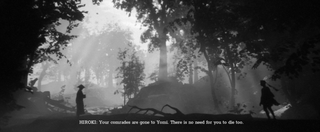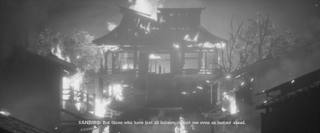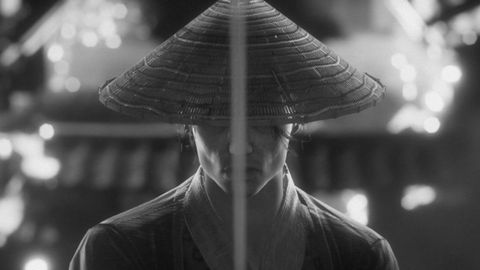Our Verdict
A gorgeous game with frustrating combat and glitchy exploration, Trek to Yomi is the definition of style over substance.
PC Gamer's got your back
Trek to Yomi copies the style of Akira Kurosawa's iconic black and white samurai films: rice fields blowing in the wind, villages burning, a great black swirling vortex in hell. Okay, so Trek to Yomi goes to some places Kurosawa's films didn't. But the path there is littered with glitches, and I only stuck it out through the finicky, floaty combat to see where my samurai's descent into madness would lead him.
What is it? A 2D side-scrolling game in which you assume the role of a vengeful samurai.
Expect to pay: $19.99
Developer: Flying Wild Hog
Publisher: Devolver Digital
Reviewed on: Intel(R) Core(TM) i7-5600U CPU @ 2.60GHz, 2.59 GHz
Multiplayer: No
Link: Steam
After his town is ransacked by bandits, protagonist Hiroki must decide whether to remain bound to his duty, protect his loved ones, or seek revenge. It's classic samurai stuff, but the story is well-told, as Hiroki faces his personal demons (also, literal demons) and I got to make decisions that influenced exactly how this samurai tragedy would end. All of the Japanese voice actors give raw performances, and Hiroki's actor in particular manages to convey his downward spiral into anger and regret.
I like Trek to Yomi's supernatural elements, too. Hiroki straddles the line between life and death as he journeys through literal hell for the latter half of the game. It reminds me of the supernatural elements of Uncharted 1 and 2, monsters and ghostly apparitions catching me off guard in what I thought was a more grounded world. They add an intriguing mysticism without being overbearing.
Unfortunately combat is weightless and repetitive, and most of the trek in Trek to Yomi is spent swinging a sword. I spent most of the game repeating the same combos, occasionally parrying enemy attacks to create openings. I had a limited supply of long-range weapons like shurikens and arrows and picked up some new sword skills along the way, like a flurry of quick strikes and a piercing thrust through armored enemies. All of them ended up feeling irrelevant when the same parry and slash routines could kill essentially every normal enemy.

I was constantly frustrated by how hard it was to tell when I'd parried an attack. The visual feedback is scant, and the vocal cue is so clipped that I could never consistently capitalize on the opening I'd made. Combat feels sloppy elsewhere too: sometimes I could see my sword slashes clearly connect with an enemy and get no reaction. Are they hiding their hitboxes inside their bodies, somehow? (If so that's one samurai technique I never learned.) Even when I did land a clean hit I didn’t feel any sort of impact unless my opponent staggered back, which was consistently difficult to trigger.
I might have forgiven some of Yomi's design misdemeanors were it not for the progress-blocking glitches
The controls and wooden animation just can't live up to the fluidity of the film duels Trek to Yomi so badly wants to emulate. After dispatching an enemy I'd hit R to turn around and face the one behind me—and nothing would happen. I’d have to mash it multiple times to get Hiroki to register the action, and the seconds I wasted with my back turned caused me to lose HP and sometimes die.
Dodging is inconsistent as well: Sometimes I’d be able to roll behind an enemy, while other times it’d be just like rolling right into a brick wall.
Enemy variety isn’t Trek to Yomi’s strong suit, either. At first you’ll be fighting bandits, and then supernatural creatures and ghostly apparitions. These enemies use the same exact character models throughout the entire game. Bosses are a rare break from the monotony and were the only enemies that challenged me to do more than mash out the same combos. One boss had me constantly adjusting my positioning on the battlefield. If I stayed too close to one side of the stage, its wind attack could blow me off and it’d be an instant game over.

Hellbound
Exploration mostly follows linear paths from story beat to story beat. At times easy puzzles stood in my way, but solving them was trivial because they all used the same design.
Outside of combat a fixed camera with 3D movement lets you explore for collectibles and upgrades, such as stamina and health increases. Often you’ll come across two paths: one that advances the story, and another that leads to some sort of collectible or upgrade. The issue here is that sometimes it’s hard to tell which is which.

Wanting to find as many upgrades as I could to make Hiroki better in combat, I’d choose one path and stick with it, hoping to find what I’m looking for. But if I chose the critical path I'd end up dropping down from a ledge that wouldn't let me back up. Trek to Yomi is generous with save points before and after nearly every encounter, so restarting from a checkpoint is usually an easy option. But it's strange and counterintuitive to have to savescum just to explore those alternate paths.
I might have forgiven some of Yomi's design misdemeanors were it not for the progress-blocking glitches. Sometimes I’d clip through the floor after jumping down from a ledge. Other times my character would vanish into the air after falling through a collapsing roof, nowhere to be found. I’d have to restart from a checkpoint to try again or close the game and relaunch it.
A few times enemy encounters simply wouldn’t activate, and enemies that were supposed to spawn just didn’t—including the final boss. I had to relaunch the game every time I died and wanted to fight it again because otherwise, the arena would be empty.
For all its visual grandeur, Trek to Yomi isn't much fun. It tries to tell a story worthy of a samurai drama, but the combat never graduates from the boring part of a sword training montage: it's just the same moves, over and over again.
A gorgeous game with frustrating combat and glitchy exploration, Trek to Yomi is the definition of style over substance.

One of my most anticipated upcoming RPGs doesn't just have a fishing minigame—it has a full 3D aquarium where you can view your biggest catches and learn fantasy fish 'lore'

Square Enix is laying off employees in the US and Europe

Leaked Dell roadmap introduces split Intel/Qualcomm lineup through to Nova Lake in 2027
